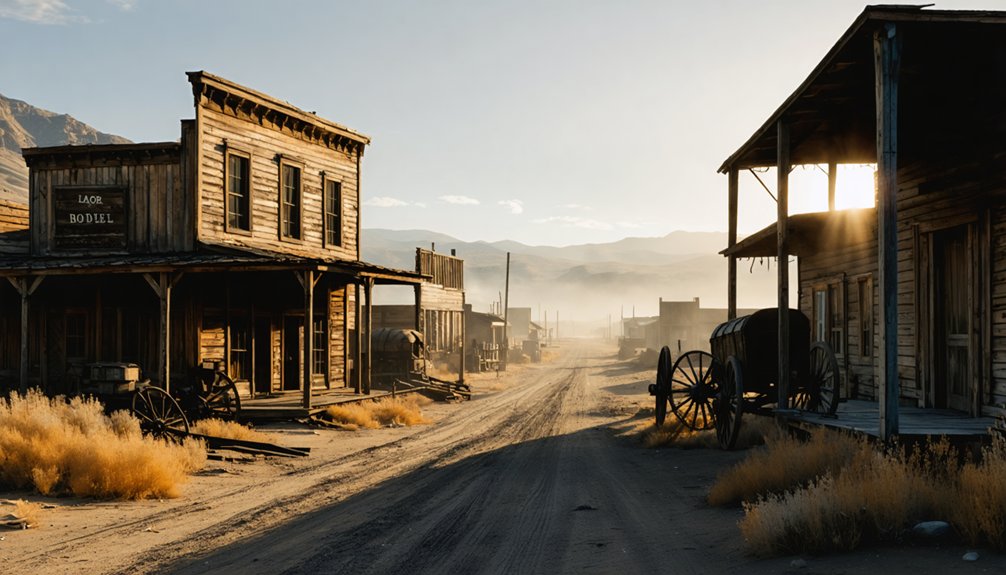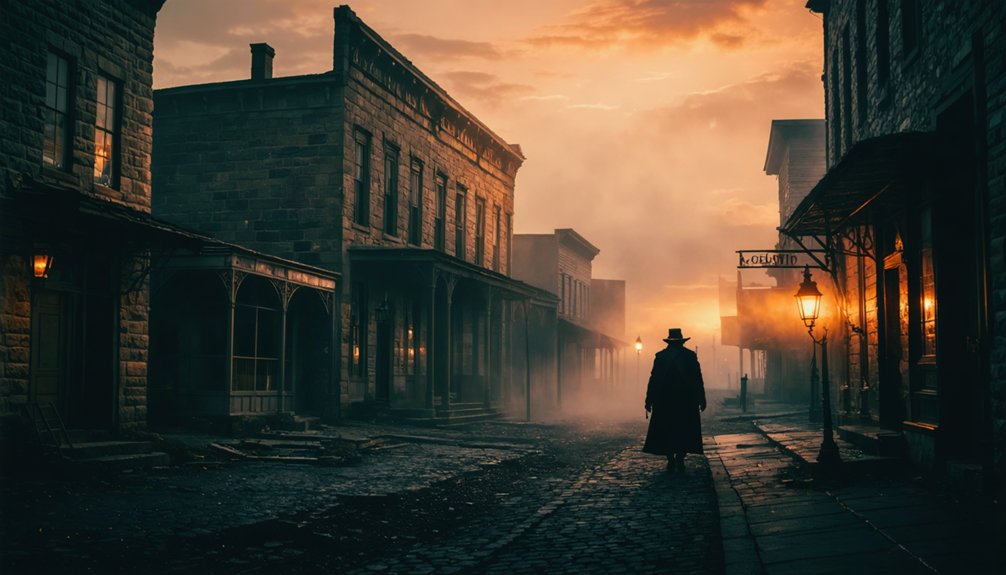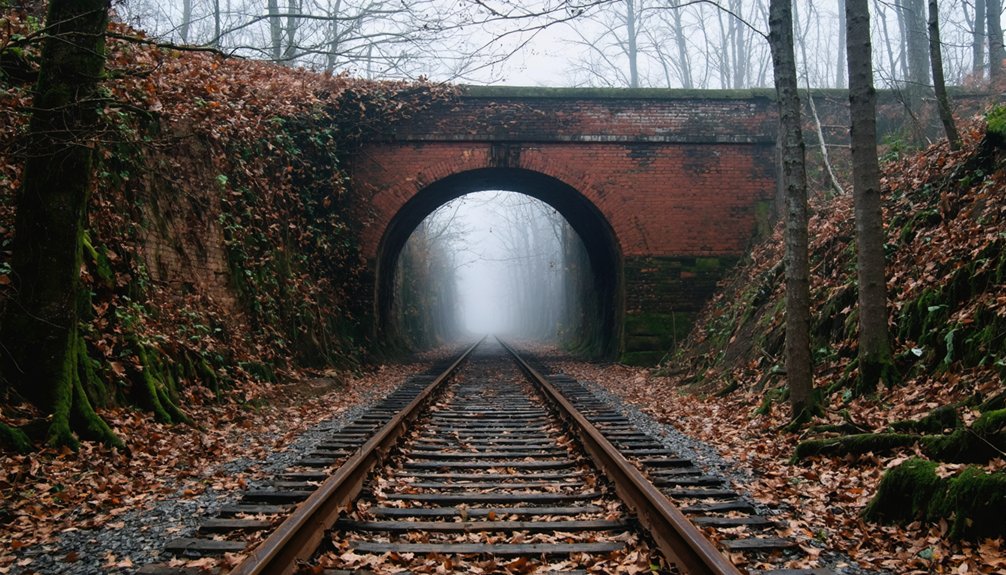You’ll find some of America’s most haunted ghost towns scattered across the Midwest, from Kansas to Wisconsin. Notable locations include Stull, Kansas, known as a gateway to Hell; Boston Mills “Helltown” in Ohio with its mysterious abandoned buildings; and Mineral Point, Wisconsin, where Cornish miners’ tales of “Tommy Knockers” still echo. These towns feature preserved structures, haunted cemeteries, and dark histories of mining disasters, supernatural encounters, and unexplained phenomena. The deeper you explore these forgotten places, the more their secrets reveal themselves.
Key Takeaways
- Stull, Kansas is home to an infamous cemetery believed to be one of seven gateways to Hell, with only twenty secretive residents remaining.
- Boston Mills (Helltown), Ohio features abandoned buildings and numerous urban legends following a 1970s government evacuation for park development.
- Lost Creek, Missouri contains unexplained phenomena like mysterious footsteps and cold spots within its reclaimed frontier landscape.
- Mineral Point, Wisconsin boasts historic stone cottages and rich mining folklore, including tales of Tommy Knockers and Piskies.
- Cairo, Illinois, a former prosperous river hub, now draws paranormal investigators with fewer than 2,000 residents and abandoned buildings.
The Eerie Legacy of Stull, Kansas: Gateway to the Unknown
Nestled in the heart of Kansas, the haunting tale of Stull began as a modest settlement known as Deer Creek Community in the mid-1800s.
By 1857, six pioneering families had established roots here, with the town later adopting its current name from Sylvester Stull, who opened the local post office in 1899.
Six frontier families planted roots in 1857, before Sylvester Stull gave the town its name with his 1899 post office.
What began as a quiet farming community transformed into one of America’s most notorious supernatural sites.
The post office operated for only a brief period before closing in 1903.
The Stull Cemetery legends emerged around its historic Methodist church, built in 1867, and the adjacent graveyard dating to the 1850s.
You’ll find centuries-old tombstones telling tales of early settlers, while supernatural sightings have made this place infamous.
Local folklore claims it’s one of seven gateways to Hell, with the Devil himself allegedly appearing during the Spring Equinox and Halloween.
Today, this small town of about twenty residents maintains an eerie silence about the legends that have made their home infamous.
Boston Mills (Helltown): Ohio’s Most Haunted Abandoned Village
You’ll find Boston Mills‘ transformation into “Helltown” began in the 1970s when the U.S. government forced residents to evacuate their homes for the creation of Cuyahoga Valley National Park.
The hasty evacuation and subsequent abandonment of the historic mill town spawned numerous urban legends, from tales of Satanic cults to stories of a haunted Presbyterian church with upside-down crosses.
The area’s history dates back to 1827 when the Erie Canal opening first attracted settlers to the region. The town grew rapidly after establishing its first mill in the early 1820s.
Today, while most paranormal investigators have found no concrete evidence of supernatural activity, the site’s boarded-up buildings and rich history continue to draw ghost hunters and urban explorers to Ohio’s most infamous ghost town.
Mysterious Local Urban Legends
Deep within Summit County, Ohio, lies the abandoned village of Boston Mills, whose transformation into the infamous “Helltown” represents one of the Midwest’s most compelling urban legends.
You’ll find that most of the ghostly tales emerged after the government’s 1970s acquisition of the land for Cuyahoga Valley National Park.
While urban folklore speaks of satanic cults, supernatural creatures, and a haunted slaughterhouse, these stories lack historical basis. The Presbyterian church’s upside-down crosses and an abandoned school bus fueled residents’ imaginations, but paranormal investigators have found no evidence to support these claims. The town’s high elevation on a hilltop adds to its mystique and inaccessibility.
Boston, established in 1806, holds the distinction of being Summit County’s oldest village, though its rich history is often overshadowed by supernatural stories.
The real story centers on the displacement of Boston Mills’ residents, whose forced relocation and the subsequent deterioration of their homes created an eerie atmosphere that continues to captivate visitors’ imaginations today.
Environmental Evacuation History
Behind the supernatural myths of Helltown lies a complex story of federal land acquisition and community displacement.
In the 1970s, the federal government transformed Boston Mills, Ohio, into part of the Cuyahoga Valley National Park through eminent domain. You’ll find that this wasn’t an environmental disaster evacuation, but rather a conservation effort that forcibly uprooted an entire community.
The government’s swift action left families with little choice as their generational homes were purchased, boarded up, and marked with “No Trespassing” signs. Critics questioned the government’s motives due to minimal development activities following the evacuation. The area, originally settled in 1806, had been the oldest village in Summit County.
Roads were barricaded, creating dead-end streets throughout the area. The environmental impact extended beyond physical changes – entire townships dissolved as residents scattered.
Some homes stood vacant for years before being demolished or burned for fire training, while others were left to decay, creating the haunting landscape you see today.
Paranormal Hotspots Today
While many abandoned towns spark curiosity, Boston Mills – infamously known as Helltown – stands as the Midwest’s most legendary paranormal hotspot.
The area’s dark history traces back to 1811 when it was first established as Boston Township.
You’ll find the remnants of this infamous village scattered throughout the area, including the Presbyterian church with its alleged upside-down crosses and the mysterious abandoned school bus that’s fueled decades of dark legends.
Today’s urban exploration reveals numerous paranormal investigation hotspots, particularly the Boston Cemetery where visitors report ghostly figures and unexplained phenomena.
Though researchers have debunked many claims using electromagnetic field detectors and infrared equipment, the town’s eerie atmosphere continues drawing thrill-seekers nationwide.
The area was forcibly evacuated when armed military personnel cleared out non-compliant residents.
You’ll encounter “No Trespassing” signs throughout the property, as most structures remain off-limits.
While many stories prove fictional – like the non-existent slaughterhouse – Helltown’s reputation as a paranormal destination endures.
Sundown in Centralia: Pennsylvania’s Eternal Fire Ghost Town
You’ll find Centralia’s streets eerily quiet today, with toxic smoke still seeping through cracks in the pavement from an underground mine fire that has burned relentlessly since 1962.
What was once a bustling coal town of 2,000 residents has dwindled to fewer than ten people, as the government condemned and demolished most buildings after the spreading inferno made the ground unstable and the air dangerous to breathe.
Through the hazy veils of smoke, you can still glimpse the few remaining structures, including the resilient St. Mary’s Church, standing as silent sentinels above the labyrinth of burning tunnels that forced this town’s abandonment.
Underground Inferno’s Ghostly Legacy
Since igniting in May 1962, a massive underground coal fire has transformed Centralia, Pennsylvania, from a bustling mining town into one of America’s most haunting ghost towns.
What began as a simple trash fire in an abandoned strip mine ignited an underground coal seam, creating an uncontrollable inferno that still burns today. Despite early fire safety measures like water pumping and clay barriers, the blaze spread through the mine network beneath the town.
You’ll find toxic gases seeping from ground fissures, creating an apocalyptic landscape that inspired the horror franchise “Silent Hill.”
The town’s population plummeted from 1,500 to fewer than 10 as homes were condemned and residents relocated. Though a few determined locals won the right to stay, their properties can’t be inherited, ensuring Centralia’s ghostly legacy will endure.
Smoke-Filled Streets Below
As darkness descends on Centralia, toxic plumes seep through fractured streets and abandoned foundations, creating an otherworldly scene in this modern ghost town.
You’ll find a haunting landscape where smoke hazards emerge from unexpected cracks and fissures, forcing most residents to abandon their homes over the decades.
The ghostly atmosphere intensifies as you navigate past condemned buildings and buckled pavement, all casualties of the relentless underground fire that’s burned since 1962.
Watch your step carefully – sinkholes could open without warning, venting dangerous carbon monoxide from the labyrinth of burning mine tunnels below.
While St. Mary’s church still stands defiantly amid the desolation, you’re walking through a federally owned wasteland where only a handful of determined residents remain in this smoke-shrouded Pennsylvania town.
The Lost Mining Camp of Bodie: A California Time Capsule

While W.S. Bodey never lived to see his namesake town flourish, the California mining camp that bears his misspelled name became one of the West’s most notorious ghost towns.
After a rich gold strike in 1876, Bodie transformed from a small outpost into a booming metropolis, where ghostly miners still reportedly roam the streets.
You’ll discover a perfectly preserved slice of the American West, where Bodie legends come alive through:
- Over 200 wooden structures frozen in “arrested decay”
- Original artifacts left exactly as they were when the last residents departed
- A haunting graveyard that tells tales of the town’s violent past
Between 1877-1882, miners extracted over $38 million in precious metals before Bodie succumbed to fires, harsh conditions, and dwindling resources.
Today, this remote state park stands as a symbol of California’s rugged mining heritage.
Spectral Sightings in Rhyolite: Nevada’s Desert Ghost Town
As you explore Rhyolite’s crumbling ruins, you’ll encounter the imposing Cook Bank Building and the unique Bottle House, both monuments to the town’s brief but prosperous mining era from 1905 to 1911.
You’ll find mysterious unmarked graves in the cemetery, where visitors regularly report orbs, disembodied voices, and the shadowy figures of former miners moving through the desert night.
The town’s rapid transformation from a bustling community of 5,000 to an abandoned shell within just five years has left an eerie energy that draws paranormal investigators and history buffs to its weathered stone walls and empty streets.
Historic Mining Mysteries Revealed
During the early 1900s, Rhyolite emerged as one of Nevada’s most promising boomtowns after prospectors Frank “Shorty” Harris and Ernest “Ed” Cross discovered gold in the Bullfrog Hills.
This historic mining settlement rapidly grew to 5,000 residents, boasting modern amenities and over 2,000 mining claims. Today, you’ll find ghostly legends intertwined with the town’s architectural remnants.
Key elements that shaped Rhyolite’s mysterious decline:
- The Montgomery-Shoshone mine’s closure in 1911 triggered mass exodus
- By 1916, the once-bustling town went dark as electricity was cut off
- The cemetery’s unmarked graves, marked only by human-shaped rock piles, fuel paranormal speculation
The Cook Bank Building stands as the most photographed ghost town structure in the West, while the railroad depot and bottle house remain as silent witnesses to Rhyolite’s dramatic rise and fall.
Ghostly Miners After Dark
Once the sun sets behind the Bullfrog Hills, Rhyolite’s abandoned streets come alive with reported paranormal activity.
The town’s cemetery, marked by piles of desert rock, serves as a focal point for ghostly encounters, where visitors report disembodied voices and mysterious orbs.
Near the red-light district, the Miner’s Cabin draws those seeking evidence of miner spirits, with many experiencing an inexplicable “vibration” after dark.
These phenomena echo the town’s dramatic history, when the Montgomery-Shoshone mine’s closure in 1911 led to rapid abandonment.
The three-story Cook Bank building and scattered ruins of saloons now stand as silent witnesses to unexplained activities.
You’ll find the most intense paranormal reports around sunset, particularly near the old opera house and train depot, where the town’s tumultuous past seems to linger in the desert air.
Desert Ruins Still Whisper
Standing amid the stark Mojave Desert landscape, Rhyolite’s weathered ruins draw paranormal investigators and curious visitors to what’s considered Nevada’s most haunted ghost town.
The town’s abandoned memories echo through crumbling structures, where ghostly encounters occur most frequently at the historic Cook Bank Building and former train depot.
Experience Rhyolite’s paranormal hotspots:
- The cemetery’s unmarked graves, marked only by human-shaped rock piles, where visitors report orbs and disembodied voices
- The opera house and schoolhouse, where spectral activity manifests through unexplained cold spots
- The general store ruins, where tourists capture mysterious figures in nighttime photographs
Once home to over 5,000 residents during the 1908 gold rush, Rhyolite’s sudden abandonment left behind countless unfinished stories.
Today, these desert ruins whisper tales of miners, accidents, and harsh conditions that claimed many lives.
Whispers From the Past: Lost Creek, Missouri
Deep within Lincoln County, Missouri, lies the vanished settlement of Lost Creek, a ghost town whose remnants tell tales of 19th-century frontier life.
You’ll find little more than whispers of its past, where a post office and farming community once thrived along the creek that gave the town its name.
Like many Midwest ghost towns, Lost Creek’s history mirrors the region’s pattern of rise and decline.
You’re walking through grounds where floods, economic shifts, and changing transportation routes gradually emptied the streets.
While specific hauntings aren’t well-documented, local folklore speaks of unexplained phenomena – mysterious footsteps, ethereal laughter, and cold spots that pierce the air.
The abandoned landscape invites you to explore what remains, though nature has largely reclaimed the site where determined settlers once built their dreams.
The Phantom Miners of Mineral Point, Wisconsin

While Lost Creek whispers its secrets through empty streets, Mineral Point, Wisconsin, roars with the spectral echoes of its mining past. As Wisconsin’s third-oldest city, this Driftless Area settlement harbors deep-rooted ghostly folklore shaped by Cornish immigrants and their phantom miners.
Ancient spirits of Cornish miners linger in Mineral Point’s weathered streets, where Wisconsin’s early settlers first unearthed the earth’s treasures.
Here’s what makes Mineral Point’s hauntings uniquely compelling:
- Cornish miners brought tales of “Tommy Knockers” and “Piskies,” supernatural beings that still supposedly inhabit the town’s historic stone cottages.
- The infamous Ridgeway Ghost, tied to a brutal 1840 murder, appears in 40-year cycles, terrorizing locals.
- In 1981, the “Mineral Point Vampire” incident at Graceland Cemetery sparked widespread panic when a pale, caped figure was spotted leaping over fences.
Today, preserved buildings like Pendarvis Historic Site stand as silent witnesses to these enduring supernatural tales.
Shadows of History: The Ghost Town of Cairo, Illinois
At the convergence of America’s mightiest rivers, Cairo, Illinois stands as a haunting reminder to the rise and fall of a once-prosperous transportation hub.
You’ll find a town shaped by its strategic location, where French pioneers first settled in 1702, and Lewis and Clark once mapped their coordinates. As steamboats and railroads flourished, Cairo grew into a bustling port city, but beneath its success lay dark undercurrents of racial violence and social unrest.
Cairo’s decline began in the 1930s, accelerated by flooding, crime, and brutal racial tensions that tore the community apart. Where 15,000 people once lived, fewer than 2,000 remain today.
The abandoned buildings and empty streets now draw paranormal investigators, who claim to encounter spirits from the town’s turbulent past.
Mysteries of Moonville: Ohio’s Abandoned Railroad Town

Hidden within the dense forests of Vinton County, Ohio, Moonville’s ghostly remains tell a tale of railroad ambition and industrial decline.
The town’s mystique centers around its infamous tunnel, where more than 21 souls met their fate along the tracks. You’ll find this 300-foot passage still standing, a monument to 1850s engineering and the dangers of early rail transport.
Deep within Moonville Tunnel’s haunted stone walls, twenty-one lost souls echo the perils of America’s railroad age.
The Moonville mystique lives on through:
- The haunting legend of Theodore Lawhead, an engineer whose lantern-bearing spirit roams the tunnel
- A mysterious “Lavender Lady” who appears near the entrance
- Shadow figures that drift through the graffiti-covered walls
Today, you can explore this remote site via the Moonville Rail Trail, where ghostly legends and historical preservation merge in the depths of Zaleski State Forest.
The Haunted Ruins of Rush, Arkansas
Deep in the Ozark Mountains of Arkansas, the abandoned zinc-mining town of Rush stands as a haunting memorial to America’s boom-and-bust mining era.
You’ll find the remnants of what was once Arkansas’s zinc capital, where 5,000 residents built their dreams during the 1880s mining boom. The town’s haunting stories echo through crumbling stone walls, rusted rails, and abandoned mine entrances.
While exploring the Rush Historic District, you’ll discover foundations of old smelters and the ghostly remains of the Morning Star Mine, where miners once extracted massive zinc specimens.
Mining folklore tells of unmarked graves and restless spirits near the deteriorating mine sites. By 1972, Rush had transformed from a thriving community into a silent ghost town, now preserved within Buffalo National River park’s boundaries, its eerie ruins a monument to forgotten frontier ambitions.
Frequently Asked Questions
What Safety Equipment Should I Bring When Exploring Ghost Towns?
You’ll need a powerful LED flashlight with backup batteries, sturdy boots, protective gloves, dust mask, hard hat, first aid kit, and GPS device for safe ghost town exploration.
Are There Any Ghost Towns That Allow Overnight Camping?
You’ll find overnight camping at Calico Ghost Town, Fayette Historic State Park, and Fish Lake Valley Hot Springs. Check camping regulations and secure overnight permits before setting up your site.
Which Ghost Towns Are Wheelchair Accessible?
You’ll find limited wheelchair accessibility at most ghost towns. Your best options include Ashcroft’s boardwalk, Red Oak II’s flat terrain, or urban ghost town tours like Whitney Mansion in Detroit.
Can I Use Metal Detectors in These Abandoned Towns?
You’ll need special permits and landowner permission for metal detecting in ghost towns. Federal and state regulations strictly protect historical artifacts, and unauthorized removal can result in serious legal consequences.
What’s the Best Season to Photograph Ghost Towns?
With 60% less tourists, fall’s your ideal time. You’ll get rich golden-hour lighting, vibrant foliage backdrops, and stable weather conditions for photography techniques that capture architectural details in ghost towns.
References
- https://www.cbsnews.com/chicago/news/five-creepy-historical-sites-in-the-midwest/
- https://www.gothichorrorstories.com/real-ghost-stories/
- https://www.travelawaits.com/2702819/most-haunted-places-midwest/
- https://www.tastingtable.com/694562/scariest-ghost-towns-country/
- https://www.riversandroutes.com/blog/why-alton-is-americas-most-haunted-small-town/
- https://en.wikipedia.org/wiki/Haunted_Towns
- https://thetravelingwildflower.com/hauntedplacestovisit/
- https://www.youtube.com/watch?v=EU4-QGwPJuM
- https://www.atlasobscura.com/lists/abandoned-places-midwest
- https://www.youtube.com/watch?v=SUsnGxOpcss



